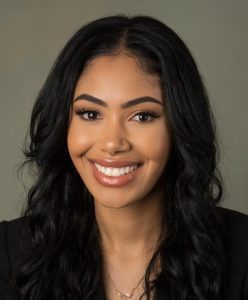As far back as elementary school in Los Angeles, Chelsea Nwonwu knew what she wanted to do with her life.
“I have notes from when I was a kid that asked, ‘What do you want to be when you grow up?’” she said. “And I said, ‘I want to be a radiologist.’ I was asked, ‘Where do you see yourself in 20 years?’ I said, ‘Hopefully going to medical school.’”
She’s checked the first item off her list. Chelsea is in her third year at the University of California, Riverside School of Medicine.

A jokingly self-described “weird kid,” she enjoyed watching medical shows when she was young. But her tastes didn’t lean toward dramas like “Grey’s Anatomy.” Instead, she was checking out programs about mystery diagnoses, processes that usually involved imaging.
“As a kid, I was amazed that you could see inside the human body without having to cut,” she said. “I thought that was cool. I didn’t know that you could image people for a living.”
While going through her rotations this year, Chelsea has been able to get a first-hand view of diagnostic radiologists at work, advancing her unique childhood TV habits into real life.
“Just going in the reading room and seeing the images … I’m a very visual learner,” she said. “I really like neuroradiology.”
What Chelsea has found is that there are many pieces that must fit to produce a diagnosis. A diagnostic radiologist is one of the people who brings everything together.
“It’s a puzzle,” she said “You’re trying to find answers. I was always interested in puzzles.”
Chelsea has been impressed by the important role that diagnostic radiologists play in diagnosing patient conditions, even if they don’t often interact with them. The reading room can be a gathering place for physicians from across the spectrum.
“(Every physician) is super important, but imaging is just so vital,” she said. “We need it in every specialty. It’s important in medicine, but it’s also often forgotten about. We’re in the back room doing a lot to help with patient care.”
The deaths of two people close to her also played a role in her career decision. Her grandmother and aunt died in Sierra Leone, a country in West Africa. Neither lived in an area where medical care was readily available. Her aunt’s nearest medical facility was closed on weekends.
“No one knew that she was having a stroke,” she said.
The tragedies re-enforced in her mind the importance of healthcare equity in general and access to imaging specifically. One of her professional goals will be to help socioeconomically disadvantaged communities.
“My life events kept reaffirming why this field is so important and how (access to health care) could have had a very huge impact,” Chelsea said.
Chelsea’s career path has been decided. From TV shows to family ties to earning her bachelor’s degree from UCLA in molecular, cell, and development biology, she’s known for years that she wanted to spend her life helping patients as a radiologist.
“I feel like it was brought to me,” she said. “I’m going strong. I’m committed.”


